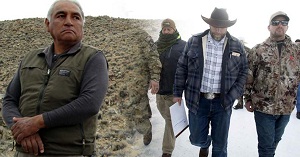What If The Armed Protesters Were Paiute Natives?by William Norman GriggJan. 05, 2016 |
Popular 
Report: Hamas Says Witkoff Promised to Lift Gaza Blockade in Exchange for Edan Alexander

Ben Shapiro, Mark Levin and Laura Loomer Warn of Foreign Influence... From Qatar

Eloy Adrian Camarillo, 17, Arrested in Shooting Death of Infowars Reporter Jamie White

NYT: Trump Ended War With Houthis After They Shot Down U.S. Drones, Nearly Hit Fighter Jets

'If Iran Abandons Its Nuclear Program, Will Israel Do The Same?': Israeli Spox Launches Into Tirade Over Pointed Question
  What if the armed protesters who seized control of empty administrative buildings on the Malheur National Wildlife Refuge were Paiute activists, rather than white militiamen? What if the armed protesters who seized control of empty administrative buildings on the Malheur National Wildlife Refuge were Paiute activists, rather than white militiamen?Would left-leaning critics of this arguably ill-considered action denounce the protest as an act of "armed sedition against lawful authority" carried out by "domestic terrorists," and call for immediate military action to slaughter the occupiers? Or would they consider the possibility that federal control over the land is illicit, the status quo untenable, and that the demonstrators are animated by legitimate grievances? Harney County, Oregon, where the standoff is taking place, was named after General William S. Harney, who rose to prominence during a punitive expedition in the 1850s to "chastise" restive Upper Brule Sioux for organizing armed resistance against white encroachment on lands supposedly guaranteed to them by treaty. In the 1860s, an outpost named after the general was established near present-day Burns, Oregon, not far from the scene of the ongoing standoff. Fort Harney played a key role in the "Snake War," a four-year campaign to subdue and assimilate the Paiute and Shoshone in Idaho, Oregon, and Nevada. That relatively obscure conflict was, in the words of historian Gregory Michno, "the deadliest Western Indian war in American history." One federal objective in the Snake War was to break the resistance of the Paiutes and confine them in a reservation. As originally constituted in 1872, the Malheur Reservation encompassed some 1,778,560 acres of land supposedly set aside for the use of nomadic Indian bands who had lived in the region since time immemorial. An official named Samuel Parrish was appointed as Indian agent in 1873, and he endeared himself to the Paiutes by treating them respectfully and dealing with them equitably. His replacement, Harrison Linville, was a more typical bureaucratic specimen, padding his requisitions and charging extortionate prices for rations which the Indians had been promised during peace negotiations. During Linville's tenure, records a Paiute tribal history, "stockmen and ranchers were pressuring the government to turn over reservation lands for settlement and grazing of cattle. They were not even waiting for a federal mandate but began to run their livestock and even build ranch homes on the reservation." Contention over the area near Fort Harney was especially acute: The Paiutes gathered camas roots -- a staple of their diet — in the fertile valley. Then, without any legitimate claim to the land, white ranchers threw up fences and began running cattle. Rather than treating those ranchers as terrorists or subversives for unlawfully seizing land held in trust by the federal government, the administration of President U.S. Grant simply ratified the illegal seizures. In 1876, President Grant "ordered the northern shores of Malheur Lake open for settlement," thereby cutting off another important harvest area from the Paiutes. Compounding the injury with an insult, Grant appointed William Rinehart, a veteran of the Snake War, as the Indian Agent. In that position Rinehart continued the effort to exterminate the Paiutes, choking off their rations and allowing white settlers to invade Paiute lands at will. Paiute Chief Egan confronted Parrish in a bid to stave off extinction. "Did the government tell you to come here and drive us off this reservation?" the Paiute Chief demanded to know. "Did the Big Father say, go and kill us all off, so you can have our land? Did he tell you to pull our children's ears off, and put handcuffs on them, and carry a pistol to shoot us with? We want to know how the government came by this land. Is the government mightier than our Spirit-Father, or is he our Spirit-Father? Oh, what have we done that he is to take all from us that he has given us? His white children have come and taken all our mountains, and all our valleys, and all our rivers; and now, because he has given us this little place without our asking him for it, he sends you here to tell us to go away." Within a few years, the Paiutes -- hungry and desperate -- joined in the regional uprising called the Bannock War. After putting down the Indian insurgency, the victorious Feds rounded up every Paiute it could find for transport to Washington's Yakima reservation. Those who evaded federal custody melted into the hills throughout the ION (Idaho Oregon Nevada) region. General George S. Crook, the U.S Army's most accomplished Indian fighter, candidly admitted that the Bannock War was provoked by the government he had served with such distinction. "It cannot be expected that they will stay on reservations where there is no possible way to get food, and see their wives and children starve and die around them," Crook wrote of the starving Paiutes and Shoshones. "We have taken their lands, deprived them of every means of living...Our Indian policy has resolved itself into a question of warpath or starvation; and, merely being human, many of them will choose the former alternative where death shall be at least glorious." From Washington's point of view, the behavior denounced by Crook was a justified exercise of "plenary" authority over Indian lands obtained through conquest of an inferior race. In the 1823 case Johnson and Gram's Lessee v. William McIntosh, the U.S. Supreme Court held that while Indians "were admitted to be the rightful occupants of the soil, with a legal as well as just claim to retain possession of it," they were denied clear title to their property -- that is, the "power to dispose of the soil at their own will, to whomsoever they pleased." Ownership of the land on which the Indians lived was supposedly transferred from them to the newly arrived Europeans through royal grants issued by monarchs whose authority was ultimately derived from the Pope. According to the Court, those decrees by distant kings of whom the Indians had never heard were sufficient to "convey the soil as well as the right of dominion to the grantees." Henry Wheaton, who was the reporter for the Supreme Court at the time of that ruling, later wrote that the Indian tribes, as "heathens," were "the lawful spoil and prey of their civilized conquerors" and that it was a "maxim of policy and of law, that the right of the native Indians was subordinate to that of the first Christian discoverer." Arch-nationalist legal commentator Joseph Story elaborated on this idea, describing the Indians as "infidels, heathens, and savages [who] were not allowed to possess the prerogatives belonging to absolute, sovereign and independent nations." The racial and religious roots of federal Indian policy have been exhumed through a lawsuit filed on behalf of Nevada cattle rancher Raymond Yowell, a former chief of the Te-Moak band of the Western Shoshone Indians. In May 2002, the BLM -- acting without a court order — mounted a paramilitary operation to confiscate Yowell's 132-head cattle herd for refusal to pay grazing fees. The rustlers then billed the rancher $180,000, and began to garnish his monthly Social Security check when he refused to pay. Yowell's ancestors were among the signatories of the 1863 Ruby Valley Treaty with the federal government, which recognized the tribe's sovereignty over a 24 million acre swath of western lands the Shoshones called Newe Segobia -- "The Land of the People of Mother Earth." While demanding that the Shoshones refrain from interfering with telegraph lines and stagecoach routes, the Feds did nothing to discourage or deter illegal settlements on Shoshone land. In 1962 -- one year shy of the centennial of the Ruby Valley Treaty -- the federal Indian Claims Commission proclaimed that this pattern of federally abetted "gradual encroachment" by Euro-American settlers and speculators had "extinguished" all Shoshone claims to their lands. A brief filed on Yowell's behalf observed that while cases subsequent to the 1823 Johnson decision "tended to omit explicit reference" to the doctrine that Indian land rights must yield to the "superior" claims of white Christian settlers, its core precepts did occasionally bob to the surface. Thus in the 1877 Beecher v. Weatherby case, the Court decreed that Indians should be dealt with in a fashion appropriate to "an ignorant and dependent race." In 1946 -- the year Congress created the Indian Claims Commission to dispose of Indian land claims -- Justice Stanley Reed batted away a suit filed by the Alcea Band of Oregon's Tillamook tribe by breezily stating that "discovery by Christian nations gave them sovereignty over and title to the lands discovered." Nothing in the US Constitution justifies the institutionalized assumption that the federal government had the right to act as "trustee" on behalf of its so-called Indian "wards." The Supreme Court struggled to find constitutional warrant for that belief in the 1886 case United States v. Kagama. When the text refused to yield the desired outcome, Justice Samuel Miller threw up his hands and concluded that the plenary authority to regulate Indian affairs grew out of "the ownership of the country ... and the right of exclusive sovereignty which must exist in the National Government, and can be found nowhere else." That ruling, one commentator wryly observed, introduced the "`it-must-be-somewhere' doctrine of Constitutional interpretation." The "finders keepers" or "might makes right" approach to Indian affairs "has never been repudiated," notes Yowell's brief. "It is the continuing basis for all aspects of federal Indian law." The federal government insists that it is acting on "well-settled" legal principles. The brief replies that "slavery and racial segregation were considered `well-settled' law, and were nonetheless subject to challenge as fundamentally incompatible with the Constitution and the principles of respect for human rights." Ammon Bundy, the de facto leader of the militia group occupying the Malheur National Wildlife Refuge, describes the objective of the standoff as the restoration of "the people's constitutional rights." He also claims that the militia intends to occupy the federal buildings "for as long as need be" and won't leave until the people of Harney County "can use these lands as free men." However, as the CATO Institute reports, property rights advocates who want to change public views need to find ranchers more appealing than the Bundys, who want to overgraze other people's land without paying for the right to do so, or the Hammonds, whose unauthorized fire on federal lands threatened firefighters' lives. Without better representatives--preferably ones willing to pay their own way and not rely on taxpayer subsidies--they won't be able to capture the hearts and minds of the American people, which means the future of ranchers who depend on federal lands is dim. If he's serious about that objective, Bundy should make specific overtures to Paiute residents of the county, who would have a great deal to say about the subject of dispossession by federal decree. After comparing notes, these two groups might come to understand that the federal Leviathan State is, and has always been, the bane enemy of people of every ethnic origin. |



